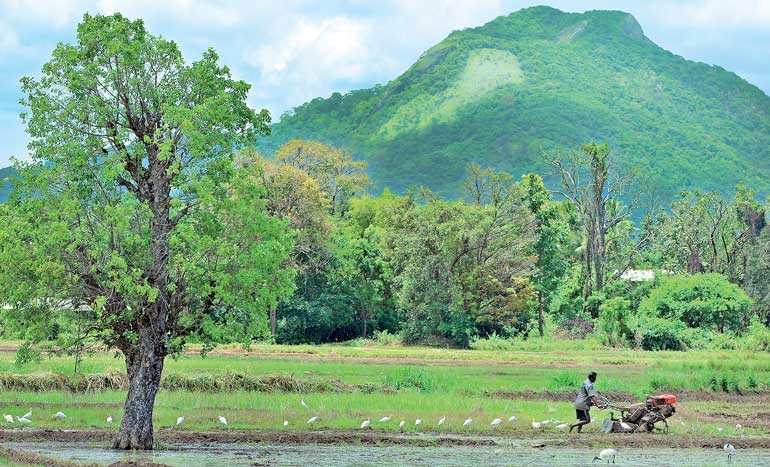Thursday Apr 03, 2025
Thursday Apr 03, 2025
Thursday, 27 September 2018 22:47 - - {{hitsCtrl.values.hits}}

Indications this year are that the weather gods are kind, will bring timely rainfall and favour paddy farmers for a bountiful Maha cultivation and harvest. But will our local gods occupying administrative seats postpone cultivation until irrigation tanks collect sufficient water? – Pic by Shehan Gunasekara
Normally rains for Maha cultivation season arrive around 20 September and the Meteorological Department has been forecasting incoming rains. Its website informed on 13 Sepetmber Mahiyanganaya received 50mm of rain.
The Accuweather website, which gives more reliable long-term weather information, has been forecasting rains over the island during next week. Its website shows how rain-clouds approach Sri Lanka from the East and rains could be expected especially in the north-central and eastern parts of the country over the next few days or weeks.
Cultivation last season
Looking back at last cultivation (Yala) season, Paddy Marketing Board (PMB) announced that they will commence purchasing paddy from farmers from 4 August. Chairman of the Board, informed that they expect to purchase up to 120,000 metric tons of paddy during this Yala season and the Cabinet of Ministers has granted approval for funds. The Department of Agriculture believes that farmers will be able to reap a total harvest of 1.4million metric tonnes of paddy this season.
During August and early September media reported stories of farmers’ problems due to shortage of cultivation water and insect attacks on cultivated paddy. Agriculture officials were advising farmers to use particular varieties of pesticides.
When PMB commenced paddy purchases in early August, PMB would be expecting to purchase farmers’ paddy harvested during July end and later. Paddy takes three to four months from sowing to harvesting, with popular varieties requiring three and half months. Thus fields matured in end-July would have been sown in mid-April.
Going backwards given maximum six weeks to prepare fields, Maha cultivation would have been harvested in February end, meaning Maha cultivation commenced in mid-November, when rainy season was at peak. Very likely these farmers would have cultivated according to government instructions. The farmers that complained of water shortage and insect attacks in August and September would have cultivated still later. There seems to be a serious problem in cultivation times of paddy farmers.
Traditional paddy cultivation
Prior to Mahaweli diversion, paddy farmers traditionally depended on rains for cultivation. In the north, north-central and eastern provinces major part of the annual rains arrive during Maha season, also the main paddy cultivation season. They areresponsible for the bulk of Sri Lanka’s rice production. Some of these paddy lands were fed from minor irrigation tanks and still others are solely rain-fed. 
Normally, Maha rains arrive around 20 September, which are normally heavy, a day’s rain exceeding 50mm. Prior to rains the fields are dry and hard, with field bunds damaged due to machinery running over during harvesting and transport. Rains soften the ground and after the first rain, farmers repair the damaged field bunds, second and third rains collect water in the fields and ploughing becomes possible, especially now considering the land preparation is mechanised. Thus, sowing of seed-paddy is possible in early October and paddy would be ready for harvesting by mid-January, now againwith a harvester. Historically, rain water collected in the tanks were reserved for Yala cultivation, but when rains are insufficient, deficiency replaced from tanks.
Thereafter, Yala cultivation could begin by mid-February and be harvested in May-end, mostly using water from reservoirs. Some farmers after the Yala harvest, assisted by minor rains in May and June fields are used for cultivation of vegetables, corn, maize and similar crops that require less water. These cultivations depend mostly on rain and for centuries the farmers used this method. Even today, some farmers continue cultivation on the same pattern and reap benefits.
Current practices
The above practice was popular decades ago, now irrigation water is supplied through major irrigation tanks administered by Government officials. Resulting bureaucrats and politicians decide on cultivation days, based on the ability to issue water for cultivation. Earlier local cultivation committees decided on cultivation days, especially when farmers were dependent on rain water or minor tanks not connected to major schemes.
Now most cultivations in North-Central and Eastern Provinces are fed with Mahaweli waters, in addition now Polonnaruwa tanks are supplemented with Moragahakanda waters. Cultivation instructions are centralised and are decided in meetings chaired by District Secretaries. Resulting, official commencement of cultivation depends on issue of water from reservoirs. Irrigation engineers could assure supply of cultivation water only when reservoirs have substantial water for immediate release, while expecting rains or canals bringing water supplementing the reservoir.
The Committee completely ignores the possibility of cultivation with the arrival of rains and delay the commencement of cultivation. Thus in some years cultivation starts only in November and some other farmers delay still further for their own reasons.
Results of delayed cultivation
With delayed cultivation, when heavy rains arrive in November/December rice plants are still young, become inundated and gets washed away. If seed paddy was sawn earlier, young plants would have reached nearly a foot height and would benefit from rains, with weeds get inundated and destroyed making weedicides unnecessary. By January rains would have ceased and dry weather assists drying of mature plants for harvesting. Late cultivation continue to need water are forced to depend of stored water from tanks, wasting precious water that could be used for next cultivation, Yala.
The staggered cultivation by different farmers, in addition to demanding excessive quantities of water, also results in a major problem, the insects. When all cultivations are together insects are few, but with staggered cultivation insects move from one field to another multiplying in numbers, the results were seen in August.
Saving precious water
During the planning stage of Mahaweli Development Project in late 1970s, World Bank officials pointed out that Sri Lankan rice farmers consume world’s highest quantum water for paddy cultivation and warned unless this consumption pattern is amended, the entire Mahaweli Project would become a failure.
The Japanese who carried out Moragahakanda planning in 1980s mentioned same and insisted 50% saving of water be necessary for optimum benefits of irrigation projects.
Moragahakanda waters to Polonnaruwa
The President released water from Moragahakanda reservoir, but according to Master Plan first users of Moragahakanda waters are beyond Yakalla, south of Anuradhapura. Upper Elahera Canal to carry water northwards from Moragahakanda tank is under construction and the completion expected only by 2024. Until such time water from Moragahakanda would only supplement waters for Polonnaruwa group of irrigation tanks and farmers there would have plenty of water irrespective of weather or part of the year, with the possibility of releasing water as demanded by farmers. The pattern would be sure to spoil the Polonnaruwa farmers, when Upper Elahera Canal is complete, Polonnaruwa farmers would no longer enjoy abundance of water and would be sure to protest.
Excess water have their problems too. Staggered cultivation with plenty of water would help multiplying insects attacking paddy fields. Also when some farmers are ready for harvesting do not require water. But others with growing paddy would require water, resulting in conflicts between farmers. Thus controlling cultivation times under cultivation committees as previously done is essential.
President’s 1,000 tanks project
The President inaugurated the 1,000 tanks project meant to renovate long-neglected small irrigation tanks mostly in North-Central Province. These minor tanks neglected over the centuries are filled with eroded soil over the years, also in most tanks bund sectionswere washed away needing repairs. Farmers in the tank renovation areas are highly pleased, with the hope able to cultivate paddy two crops a year.
Paddy is the most favoured crop among the farmers, where most aspects of cultivation is mechanised except for sowing of seed paddy, which allows the farmer to idle most of cultivation period while being assured of a sizeable income. With the renovation of a large number of small tanks and intensive cultivation of Polonnaruwa tanks, the country’s rice output would sure to exceed consumption. Current rice production is only marginally lower than the requirement, with production being affected by adverse weather.
Few years ago, with consecutiveseasons of good harvests, production exceeded consumption. The Government had to intervene purchasing excess stocks to prevent a price crash. But the rice was not exportable as the produce quality was not consistent. The Government was forced to dispose excess stocks as food aid through United Nations.
Farmers’ hopes
Every farmer wishes for a successful cultivation season. The primary requirement for such success is the proper supply of water; which depends on sufficient rainfall, correct quantities at proper times. Excessive rains could be more devastating than insufficient rainfall.
Current indications this year are that the rain gods seem to be kind and would ensure rains at the proper time, commencing around 20 September for the major paddy cultivation regions. Farmers continuing with the ancient traditional method would commence paddy cultivation with the first few rounds of rain. Afterwards is a low rain period with heavy rains expected in November/December. Dry weather commences from early January helping to dry the mature crop.
If our administrators want to postpone cultivation until irrigation tanks collect sufficient water for irrigation release, weeks and months will pass by, wasting precious rain water fallen on paddy fields. The majority of our farmers are lazy and would wait until the auspicious day declared by the administrators. Yet some others would waste further days and weeks prior to cultivation. The farmers who missed the cultivation for a few days for some reason still could join earlier cultivators by using a three-month variety of paddy, thereby catching up the lost two weeks.
Indications this year are that the weather gods are kind, will bring timely rainfall and favour paddy farmers for a bountiful Maha cultivation and harvest. But will our local gods occupying administrative seats postpone cultivation until irrigation tanks collect sufficient water? If our administrators too could learn and advice farmers to adhere to time-tested past traditions, every farmer will be assured with a plentiful harvest, without insect problems, while saving collected water in irrigation tanks for the Yala cultivation.
Discover Kapruka, the leading online shopping platform in Sri Lanka, where you can conveniently send Gifts and Flowers to your loved ones for any event including Valentine ’s Day. Explore a wide range of popular Shopping Categories on Kapruka, including Toys, Groceries, Electronics, Birthday Cakes, Fruits, Chocolates, Flower Bouquets, Clothing, Watches, Lingerie, Gift Sets and Jewellery. Also if you’re interested in selling with Kapruka, Partner Central by Kapruka is the best solution to start with. Moreover, through Kapruka Global Shop, you can also enjoy the convenience of purchasing products from renowned platforms like Amazon and eBay and have them delivered to Sri Lanka.
Discover Kapruka, the leading online shopping platform in Sri Lanka, where you can conveniently send Gifts and Flowers to your loved ones for any event including Valentine ’s Day. Explore a wide range of popular Shopping Categories on Kapruka, including Toys, Groceries, Electronics, Birthday Cakes, Fruits, Chocolates, Flower Bouquets, Clothing, Watches, Lingerie, Gift Sets and Jewellery. Also if you’re interested in selling with Kapruka, Partner Central by Kapruka is the best solution to start with. Moreover, through Kapruka Global Shop, you can also enjoy the convenience of purchasing products from renowned platforms like Amazon and eBay and have them delivered to Sri Lanka.